1. Prologue
The state of the shed late in 2022: the GT was fine for shopping and general messing about, with wide bars, fat tyres and a basket, and the Trailblazer was fast and light on roads and gravel tracks. Both of them were cheap and simple to work on, too, with their rim brakes, QR hubs, tubed tyres, and basic but respectable groupsets. But with another kid on the way, we needed (✌needed✌) a baby bike. I’d parted out the Kaffenback early in 2022 but hadn’t yet figured out how to replace it: the Muddy Fox was too nice to saddle with a Hamax child seat, and the GT’s wide seatstays meant a Hamax wouldn’t fit at all.
But if the GT was a restomod 26er and the Trailblazer was a retro alloy gravel bike, there was a hipster bike niche I hadn’t yet tapped: the midcentury French randonneur beloved of BQ, Vélo Orange and Path Less Pedaled. You know the sort: a steel frame; 650b wheels, as likely as not, with plush gumwall tyres; polished alloy mudguards; and a cheeky little carrier perched over the front wheel. For brakes, think cantilevers, or, if you’re lucky, centrepulls.
The irony was that my old Peugeot UO-12, in all its Frenchness, would have been the perfect vehicle for a faux-rando rebuild, but I hadn’t had the money or the time or the enthusiasm to give it yet another makeover. And, well, I had sold it, which was a rather more final “no” on that front. There’s a second irony here too, but we’ll get to that later.
2. The purchase
To eBay, then, where I found this bad boy for £130 in September 2022:
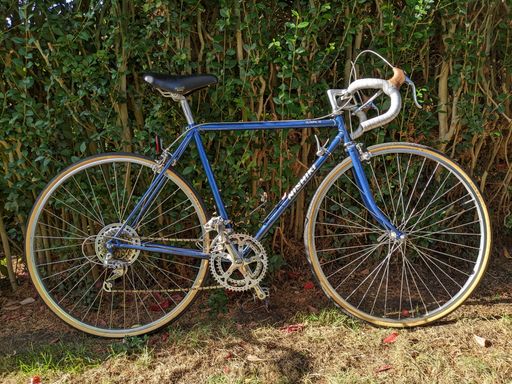
It was a Nishiki Olympic 12, a lugged, made-in-Japan road bike with 27″ wheels, a 2×6 Suntour groupset, and an overall demeanour which, to my eye, placed it in the early ’80s. The seller, a Google engineer based in London, didn’t know when it had been produced, but the internet obliged: according to the “Nishiki Serial Number Database” thread on BikeForums, it was a 1983 model produced for sale in the USA.1 This one seems to have stayed there for a while, as evidenced by this somewhat-recent sticker for Orange Cycle Works in Orlando:
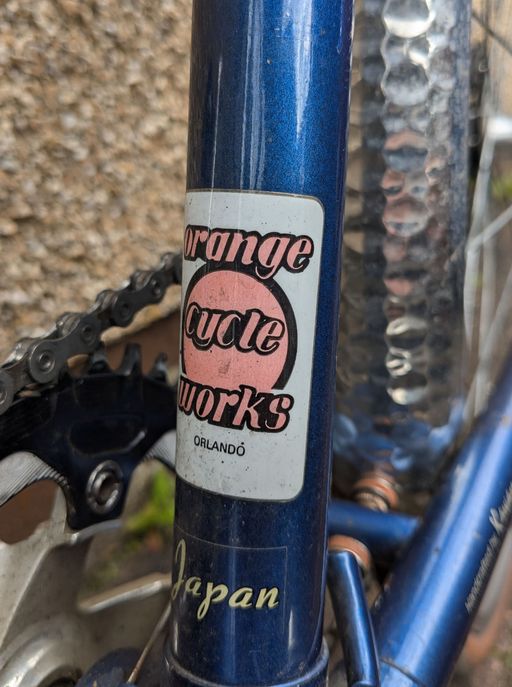
The owner told me that he had spent around £150 having the bike serviced and upgraded, although, consumables aside, it still seemed mostly original. The brakes were appropriately terrible: flexy, single-pivot Dia Compes hooked up to non-aero brake levers with under-bar extensions which, added to a pair of very large, very visible reflectors, give the bike an exquisitely dorky aspect. The 27″ wheels were fine, I guess, except that there was little tyre clearance left – clearance I would need for mudguards and/or fat 650b tyres.
The drivetrain was more interesting. The “drillium” chainrings were a little overwrought, but the sleek ARX derailleur was a lovely component. (It had been, apparently, Suntour’s attempt to catch up to Shimano’s blockbusting, aerodynamic 600 groupset.) Even more intriguing were the “Symmetric” Suntour shifters, where the two shifters shared a blocky clamp-on alloy mount rather than being bolted to the down tube itself. Inside that mount was a cam that pushed the left/front shifter subtly fore and aft as the right/rear shifter was moved, thereby trimming the front derailleur to match the rear. I didn’t ride the bike much with the Symmetric shifters in place, but they seemed to work well enough.
3. The first cut
The plan, inasmuch as I had one, was to replace the 27″ wheels with smaller ones, fit some pretentious alloy mudguards, and upgrade the drivetrain with more modern components from the shed. The bike’s first incarnation, then, was this accidental gravel grinder:
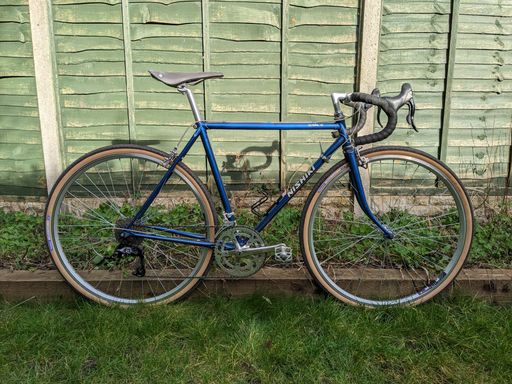
I hadn’t been able to find any 650b wheels for a reasonable price, and I was also sceptical that the brakes would reach. Instead, I went for a pair of cheap 700c Tru-Build wheels and wide-ish 35mm Panaracer Paselas to try things out. Having eyeballed the clearances before ordering, it turned out that the wheels and tyres fitted but that there was no room for mudguards.
Another issue was the angle of the brake hoods. The bars had a wide-open curve that did not work well with modern brifters, so I spent a lot of time BDHUing things around until I reached an acceptable compromise between aesthetics and ergonomics.
For rear shifting I used the same Campy brifters/Sram derailleur setup that had worked well on other bikes, but I now had a front derailleur to worry about as well. My old Veloce front shifter had gone wrong at some point (it would wind in the cable but not release it), so I spent an evening dismantling and rebuilding the shifter until it worked again and then hooked it up to the front derailleur.
What happened next was supremely dismaying. I changed into the big ring: fine. I dropped down to the small ring: fine. I changed into the big ring again: crunch. The derailleur’s return spring was so strong that the derailleur stayed put and the gear cable ripped through the plastic internals of my front shifter. It was utterly kaput. Rather than buy a new one, I gutted the brifter to leave only the brake lever, then installed the cheapest downtube shifter I could find for a Lance Armstrong-style shifter-mullet approach. It worked; it had a piratical charm about it; and it cost £13. It would do.
And, all in all, the bike was fine. The brakes were still terrible and the front shifting was awkward, but it rode well enough. Now to make it practical.
4. Practical matters
The next step was, I hoped, straightforward: find and fit narrower tyres and alloy mudguards. The tyres were the easy part: Goodyear’s “Eagle Sport” model came in a 30mm width and road.cc liked them very much. £54 for the pair, which seemed reasonable. The guards were more difficult. Smooth, hammered or fluted? How wide? I knew only that I wanted aluminium rather than plastic, after having been disappointed by flexy SKS Bluemels on other bikes.
In the end, the decision was more or less made for me. The tyres would need 40mm or wider guards, and the frame wouldn’t take much more than that. Based on what was in stock at the time, I went for hammered 45mm Vélo Orange guards at £75 for the pair. That’s right; together, the mudguards and tyres alone were almost the same price as the bike itself. (In hindsight, smooth guards might have been more in keeping, but experience shows that the hammered finish hides scratches and bashes.)
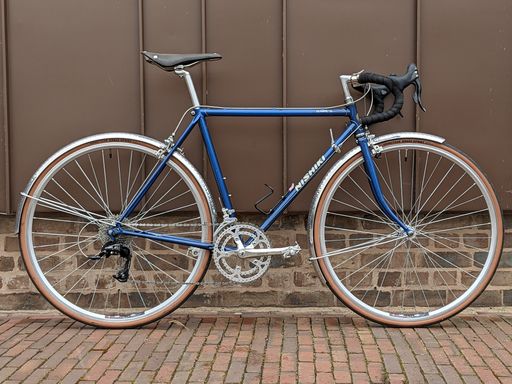
Fitting the guards was an exercise in frustration. I found a comprehensive guide to doing so at the “Eléctricalités A.T.” blog,2 but even after re-radiusing the mudguards, dimpling them to fit between the chainstays and under the fork crown, and cutting and bending the stays just so, I was stymied by the frame itself. The brake bridge was just too low: when bolted on with the supplied L-bracket, the rear mudguard was so low as to be almost touching the tyre.
There was no easy solution. I filed out the L-bracket’s vertical slot so as to to slide it as high as possible, only to find that the brake bolt running through that hole interfered with the bolt that attached the mudguard to the L-bracket. I bought a Sheldon-style fender nut to take the brake bolt out of the equation and finally managed to attach the L-bracket properly. The fender line isn’t great, but it isn’t terrible either.
The pay-off was that the finished bike was a bit of a revelation. It looked the part, and was quick and quiet on the road even if the brakes were still dreadful. I kept it in this guise for a few months.
5. The finished article
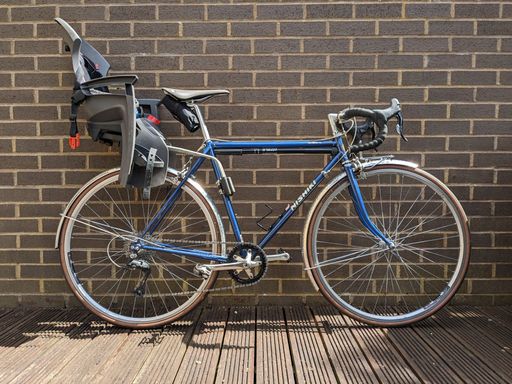
By the middle of 2023, our son was old enough to use our Hamax bike seat, so on it went. Here, finally, was where reality intruded. The brakes were genuinely awful, and the extra weight only made them worse. The notchy threaded headset kept coming loose. Shifting at the front was a delicate and awkward operation, and shifting at the back was increasingly unpredictable, with the two highest gears resisting all efforts to get them indexed properly. For whatever reason, my usual 10-speed Sramergo setup was not working very well on this bike.
Better braking was non-negotiable, so, on Jan Heine’s recommendation, I found some Weinmann Vainqueur centrepull brakes on eBay. And indeed, they elevated the braking from “bad” to “marginal”. (More successful was the added touch of randonneur élan.) To make sure we would never be stranded by a puncture, I splurged on a Carradice tool roll to carry a tube and some tools and found a Zéfal frame pump for a fiver at SJS. And for the headset, whose knurled top cap and double lock nuts defeated the internet hint factory, I bought a pair of cheap C-spanners and filed them down to fit into the notches on the lock nuts, then reballed the bearing races. I think it is finally working properly. (Those C-spanners now live in the tool roll, just in case.)
I gave up on the 2×10 Sramergo drivetrain, swapping the precious drillium chainrings and front mech for a brutish narrow-wide Hope chainring I’d taken off the Kaffenback. At the back, I swapped in an 11-34 9-speed cassette and a Deore derailleur set up to use Hubbub cable routing, and all is right with the shifting. It does not exactly radiate elegance, but it has been absolutely reliable so far and I have not yet run out of gears.
The finishing touch was a dainty Ene Ciclo carrier mounted to the front brake. It is, in all honesty, utterly pointless. I tell myself that it’s protecting the front mudguard, but really it’s doing nothing more than adding mass. There rack has no eyelet to brace the mudguard, and I wouldn’t trust the single brake bolt to securely carry a bag of any weight at all. Perhaps one day I’ll mount a light to it, but the endless Scottish summer evenings mean that isn’t a decision I’ll have to make any time soon.
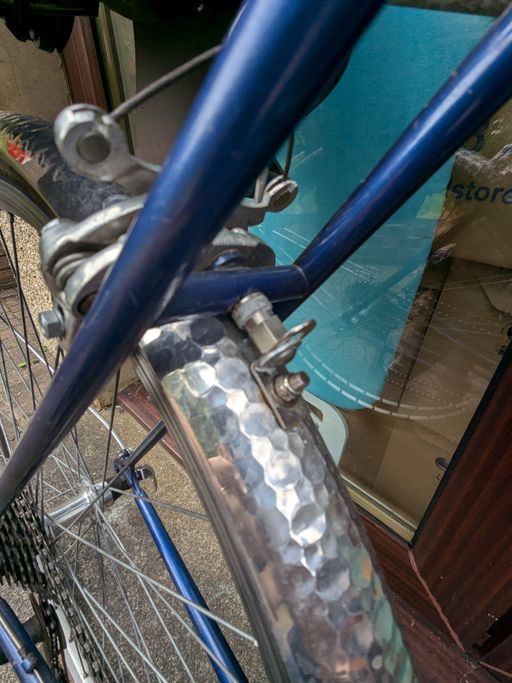
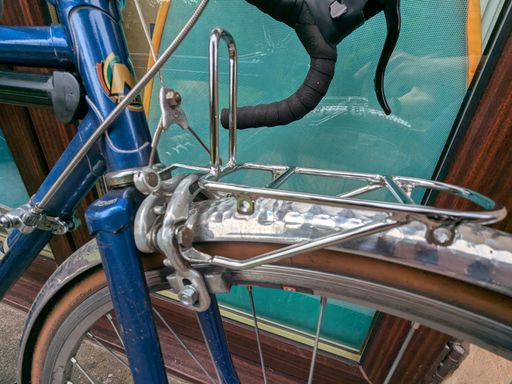
6. Life goes on
Why am I writing all of this? Why have I just expended two thousand words on a hundred-pound frame running cheap wheels and a cobbled-together groupset? I don’t know, entirely, but I do have an inkling that there is value to be had from documenting the mundane evolution of a bike like this – one that has a place in a life, or in a family. Certainly, the Olympic cyclist Riley Missel has written a far better piece than this on her own Olympic 12 and its place in her journey as an athlete, and I hope that she doesn’t mind making room for this much more modest essay. I’m older than Riley, and I’m past the stage where a bike is going to change my life. But this one may yet shape my son’s life in some small way. Perhaps he’ll learn to enjoy cycling as much as I do. Perhaps he’ll see something from the back that stays with him as we cycle past the loch and the castle – a sunset or a seagull or a fox. Perhaps he won’t remember anything at all about this bike, but this piece will be here for him to learn about it. And that alone makes it worthwhile.
7. Postscript
That second irony? Back in 2009, as I scoured Craigslist’s Vancouver forums for a road bike sacrifice to the fixie gods, my first choice had been a Nishiki Olympic 12. $255 Canadian – about £140 in today’s money – for sale by a seller in downtown Vancouver. The seller was too slow to reply to my email and I bought the Peugeot without ever laying eyes on the Nishiki. Things could have been different and the same all at once.
| Component | Model | Notes |
|---|---|---|
| Frame and fork | 1983 Nishiki Olympic 12 | |
| Wheels | Tru-Build wheels with Mach1 240 rims | Cheap 700c, 36 hole wheels with unbranded hubs |
| Tyres | Goodyear Eagle Sport | 700×30mm |
| Brakes | Weinmann Vainqueur 999 | |
| Shifters | Campagnolo Veloce | 3×10, but the left-hand shifting mechanism has been removed. |
| Crankset | Sugino RT double | Currently running the chainring in the inner position for the best chain line, but the bottom bracket spindle can probably be shortened to reduce the Q-factor and, more importantly, to move the chainring into the aesthetically superior outer position. |
| Chainring | Hope Retainer Ring | 42-tooth, 110 BCD |
| Rear derailleur | Shimano Deore M531 | 9 speed, long cage |
| Cassette | Shimano Deore XT CS-M770 | 9 speed, 11-34. Probably the fanciest component on the bike, and I have no recollection of ever buying it. |
| Bars | Sakae Custom Road Champion | |
| Stem | “Custom” branded single-bolt quill stem | |
| Headset | Unbranded threaded headset | Two locknuts and a knurled top cap, and it still doesn’t stay tight. I have a Tange headset waiting to replace it, and it can’t happen soon enough. |
| Seatpost | BLB Groove | I have one of these on the Trailblazer, and it is fine. Here, the CNC’d grooves have been wrecked by a protruding piece of steel in the seat clamp. Oops. |
| Saddle | Brooks Cambium C15 | An older model with unpainted rails |
In fact, the entire Nishiki brand seems to have been conceived specifically for the US market, with frames fabricated by a Japanese manufacturer called Kawamura and models that were kitted out with an array of Japanese components. ↩︎
There are four entries in this series, all of them very useful: Achieving a proper arc radius, Stress-relieving before mounting, Dimpling the fenders, and Installing the stays. Well worth reading before you start to install your alloy mudguards. ↩︎